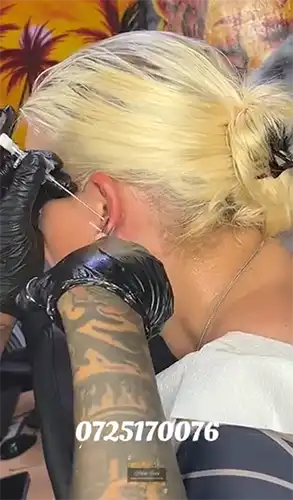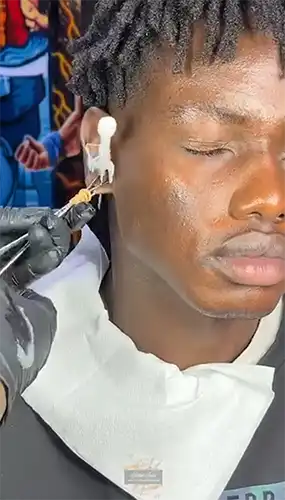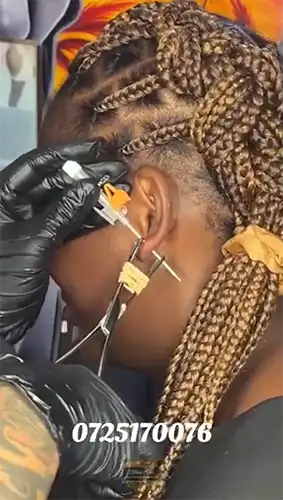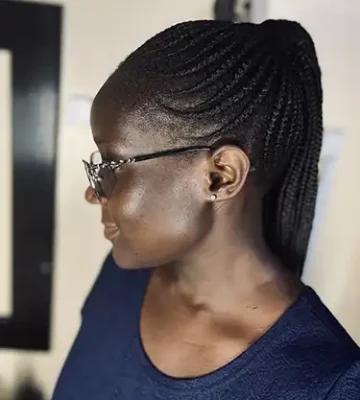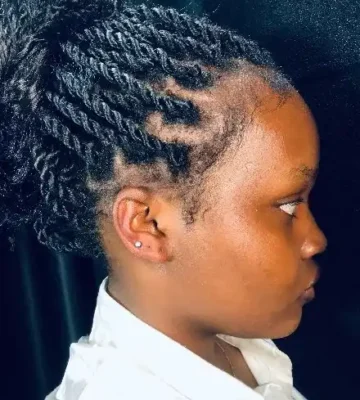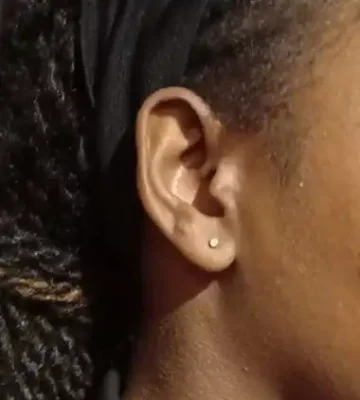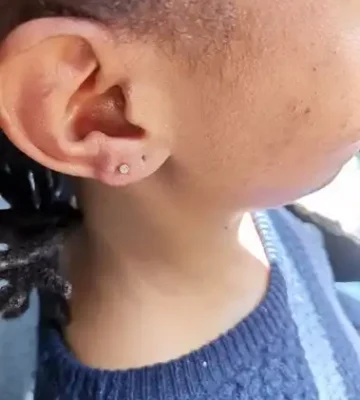Ear Lobe Piercing in Nairobi, Kenya
Ear Lobe Piercing is the process of creating a small hole in the soft, fleshy lower part of the ear (the earlobe) to insert jewelry such as earrings. It is one of the most popular and simplest types of body piercings, often considered a cultural, personal, or fashion statement.

Ear Lobe Piercings
Key Features of Ear Lobe Piercing
- Location: The fleshy, soft lower part of the ear.
- Pain Level: Generally low, often described as a quick pinch.
- Healing Time: Approximately 6 to 8 weeks.
- Jewelry Options: Wide variety, from simple studs to decorative hoops.
Earlobe Piercing Procedure: A Step-by-Step Guide
Earlobe piercing is a common and relatively straightforward procedure. Here’s a step-by-step guide to what you can expect during an earlobe piercing:
- Choosing a Reputable Piercing Studio: Before you begin the piercing process, research and select a reputable piercing studio. At Rebel Inks Tattoo Removal and Piercing Parlour we follows strict hygiene and safety standards, we use sterile equipment, and employs experienced piercers.
- Consultation: When you arrive at the piercing studio, you’ll typically have a consultation with your piercer. During this discussion, you can talk about your preferences for jewelry and the placement of the piercing.
- Preparation and Sterilization: Once you’re ready for the procedure, your piercer will clean and sterilize the earlobe area where the piercing will be done. This step is crucial to minimize the risk of infection.
- Marking the Piercing Spots: Our piercer will use a marker or a sterile pen to mark the precise spots on your earlobes where the piercings will be placed. This is to ensure that the piercings are symmetrical and aligned with your preferences.
- Piercing:
– With the markings in place, our piercer will use a sterilized needle or a piercing gun to create the holes for the earrings.
– If a needle is used, it is typically a hollow needle that cleanly removes a small section of tissue, creating a hole for the jewelry. If a piercing gun is used, it may cause more trauma to the tissue and is generally considered less optimal for piercing. - Inserting the Jewelry:
– Immediately after creating the holes, your chosen earrings will be inserted into the piercing. Common jewelry options for earlobe piercings include studs, hoops, and various decorative earrings.
– Our piercer will make sure the earrings are secure and provide you with any necessary instructions for cleaning and care. - Aftercare Instructions:
Our piercer will provide you with detailed aftercare instructions. These typically include cleaning the piercings with a saline solution and avoiding touching the earrings with dirty hands.
– It’s important to follow these instructions carefully to promote proper healing and reduce the risk of infection or complications. - Healing Process:
– Earlobe piercings usually take several weeks to a few months to heal fully. During this time, it’s essential to be patient and gentle with your piercings.
– Avoid changing earrings too soon, as this can disrupt the healing process. - Follow-Up:
– At Rebel Inks Tattoo Removal and Piercings Parlour we recommend a follow-up appointment to ensure your piercings are healing correctly and to address any questions or concerns you may have.
– Individual healing times can vary, and the key to a successful earlobe piercing procedure is to choose a reputable studio, communicate your preferences with your piercer, and follow the aftercare instructions diligently to enjoy your new earlobe piercings without complications.
Considerations before getting a Ear Lobe Piercing
Before getting an ear lobe piercing, it’s essential to consider the following to ensure a smooth experience and avoid complications:
- Choose a Reputable Studio
– Ensure the studio follows strict hygiene practices and uses sterile equipment.
– Look for certified and experienced piercers.
– Check online reviews or ask for recommendations. - Understand the Procedure
– Familiarize yourself with how the piercing will be done (needle vs. piercing gun).
– A needle is often preferred as it is more precise and reduces trauma to the tissue. - Assess Your Health
– Avoid piercing if you’re feeling unwell, as your body needs to focus on healing.
– Inform the piercer if you have any medical conditions, such as:
→ Diabetes
→ Blood clotting issues
→ Allergies (e.g., to metals or antiseptics). - Decide on Jewelry
– Choose hypoallergenic materials like surgical stainless steel, titanium, or 14k gold to minimize allergic reactions.
– Start with small, lightweight studs for easy healing. - Pain Tolerance and Sensitivity
– Ear lobe piercing is relatively low in pain, but individual tolerance varies.
– Expect a quick pinch followed by mild soreness for a day or two. - Aftercare Commitment
– Cleaning the piercing twice a day with saline solution is crucial to prevent infection.
– Avoid sleeping on the pierced ear and keep hair or accessories away during the healing process. - Lifestyle Considerations
– Consider your work or school dress code if there are restrictions on visible jewelry.
– If you engage in activities like contact sports, be cautious about accidental snagging. - Timing: Avoid getting pierced before major events or vacations where aftercare might be challenging (e.g., swimming or excessive sweating).
Pain and Healing for an Ear Lobe Piercing
Pain Level
- Low Pain: Ear lobe piercings are among the least painful body piercings due to the soft, fleshy tissue.
- Duration: The discomfort is typically a quick pinch during the procedure, followed by mild soreness for a day or two.
- Pain Variability: Pain levels depend on individual tolerance, but most people describe it as manageable.
Pro Tips for Minimizing Pain:
- Stay relaxed; tension can heighten pain.
- Eat a meal before your appointment to maintain energy.
- Trust an experienced piercer to ensure a quick and smooth process.
Healing Time
- Initial Healing: 6–8 weeks on average, though some people heal faster.
- Full Healing: Up to 3 months for the tissue to fully strengthen.
Healing Process Stages
- First Few Days:
– Mild swelling, tenderness, and redness are normal.
– Avoid unnecessary touching to prevent irritation. - Week 1–4:
– Slight itching as the skin heals.
– Crust formation around the jewelry is part of the healing process. - Week 4–8:
– The lobe begins to stabilize, with reduced sensitivity.
– You may feel comfortable, but avoid changing the jewelry until fully healed.
Tips for Faster Healing
- Clean Regularly: Use a saline solution twice daily; avoid alcohol or hydrogen peroxide.
- Avoid Irritation:
– Don’t twist or play with the jewelry unnecessarily.
– Sleep on your back to avoid pressure on the piercing. - Stay Hydrated and Eat Healthy: A well-nourished body heals faster.
- Watch for Infections: Seek professional help if you notice excessive redness, swelling, or discharge.
Ear Lobe Piercing Aftercare Guide
Proper aftercare is essential to ensure your ear lobe piercing heals quickly and without complications. Here’s a detailed guide:
- Cleaning the Piercing
– Use Saline Solution:
→ Clean the piercing twice a day using a saline solution or a piercing-specific aftercare spray.
→ Avoid alcohol, hydrogen peroxide, or harsh antiseptics, as they can irritate the skin.
– Gentle Cleaning Steps:
→ Wash your hands thoroughly before touching the piercing.
→ Dip a clean cotton pad or swab in the saline solution and gently clean around the piercing.
→ Remove any crusty buildup but avoid over-cleaning to prevent dryness. - Handling the Jewelry
– Avoid twisting or moving the jewelry unnecessarily; this can irritate the piercing.
– Ensure the jewelry stays in place for at least 6–8 weeks or until fully healed.
– Always check that the jewelry is secure but not overly tight. - Protecting the Piercing
– Avoid Contaminants:
→ Keep hair, makeup, and hair products away from the piercing.
→ Refrain from swimming in pools, hot tubs, or natural bodies of water during the healing period.
– Avoid Sleeping on the Piercing:
→ Sleep on your back or opposite side to prevent pressure on the new piercing.
→ Use a travel pillow for added comfort and protection. - Lifestyle Adjustments
– Avoid touching the piercing with unwashed hands.
– Be mindful of clothing and accessories that could snag on the jewelry.
– Stay hydrated and maintain a healthy diet to support healing. - Watch for Complications
– Normal Signs: Slight redness, mild swelling, and minor crusting in the first few days.
– Signs of Infection: Persistent redness, swelling, pain, or yellow/green discharge.
→ If infection occurs, consult your piercer or a healthcare provider. - When to Change Jewelry
– Wait at least 6–8 weeks or until the piercing is fully healed before changing jewelry.
– Choose hypoallergenic materials such as surgical steel, titanium, or gold for replacements
Ear Lobe Piercing Jewelry: Types and Recommendations
Choosing the right jewelry for your ear lobe piercing is essential for comfort, style, and healing. Here’s a guide to help you make the best choice:
Initial Jewelry Options
For new piercings, opt for jewelry made from hypoallergenic materials to minimize irritation and promote healing.
- Studs
– Features: Simple and lightweight, with a flat back or butterfly clasp.
– Best Materials: Surgical stainless steel, titanium, niobium, or 14k gold.
– Why Choose: They stay secure and are easy to clean during the healing process. - Captive Bead Rings (CBRs)
– Features: Circular ring with a small bead that keeps the jewelry in place.
– Best Materials: Titanium or surgical steel.
– Why Choose: They allow more airflow and are easy to rotate for cleaning.
Jewelry Materials
- Surgical Stainless Steel: Durable, affordable, and hypoallergenic.
- Titanium: Lightweight, hypoallergenic, and ideal for sensitive skin.
- Niobium: Similar to titanium but softer; another excellent choice for sensitive skin.
- Gold (14k or higher): Avoid plated or gold-filled jewelry to prevent irritation.
- Platinum: A luxurious and safe option for sensitive skin.
Jewelry for Healed Piercings
Once your piercing has healed (6–8 weeks or more), you can experiment with various styles:
- Hoops: Available in various sizes and designs, from minimalist rings to ornate styles.
- Drop Earrings and Dangling Styles: Add elegance and flair to your look but avoid heavy designs that can pull on the lobe.
- Decorative Studs: Options include gemstones, shapes, and themed designs for every occasion.
- Gauges or Plugs (for stretched lobes): Perfect for those who prefer an alternative aesthetic.
Tips for Choosing Jewelry
- Avoid Cheap Metals: Nickel and other low-quality materials can cause allergic reactions or irritation.
- Consider Weight: Opt for lightweight designs to prevent strain on the piercing.
- Check Secure Fastenings: Ensure the backs or clasps are snug to avoid losing the jewelry.
- Hygiene: Always clean jewelry before inserting it, even if your piercing is healed.
Cost of Ear Lobe Piercing in Nairobi, Kenya
The cost of an ear lobe piercing can vary depending on several factors, including the location, the reputation of the piercing studio, the expertise of the piercer, the quality of the jewelry used, and any additional services provided.
General Cost Range
- Basic Piercing: Ksh. 1,500 –Ksh. 2,500 (includes standard jewelry, like surgical steel studs).
- Premium Piercing: Ksh. 2,500 –Ksh. 4,500+ (includes high-quality or specialty jewelry, like titanium or 14k gold).
Factors Influencing the Cost:
- Piercing Studio: Piercing studios in different areas may have varying price ranges. Rebel Inks Tattoos, Tattoo Removal, and Body PiercingsParlour is located in the heart of the Central Business Disrict (CBD) in Nairobi, Kenya, and is easily accessible to both locals and foreigners in the country
- Piercer’s Expertise: Experienced and highly skilled piercers may charge more for their services compared to newer or less experienced piercers. At Rebel Inks Tattoos, Tattoo Removal, and Body Piercings Parlour we have experienced professionals who offer quality and premium services.
- Quality of Jewelry: The type and quality of jewelry used for the piercing can affect the overall cost. Higher-quality jewelry made from materials like surgical-grade stainless steel, titanium, or gold may come with a higher price tag compared to standard jewelry options.
- Additional Services:
– Aftercare kits (saline solution, cleaning wipes): Ksh. 500 – Ksh. 1,000
– Upgraded jewelry or add-ons: Ksh. 500 – Ksh. 1,500+.
Ear lobe Piercing Price Breakdown Table
Service / Component | Estimated Cost (KSh) | Details |
Single ear lobe piercing (basic) | 1,000 – 1,500 | Standard surgical‑steel stud; needle recommended |
Both ear lobes (basic package) | 2,500 | Often includes procedure + standard jewelry |
Premium jewelry upgrade (titanium/gold) | 500 – 1,500 | Optional higher quality material |
Aftercare kit (saline, wipes, balm) | 500 – 1,500 | May or may not be included |
Touch-up or check-up consultation | 500 | Standard follow-up fee |
At Rebel Inks Tattoos, Tattoo Removal, and Body Piercings Parlour we take pride in being a reputable piercing studio with experienced piercers who prioritize hygiene and safety. While cost is a consideration, it’s crucial not to compromise on quality when it comes to body piercings. Be sure to inquire about the total cost upfront and ask about the materials used for the piercing and jewelry to ensure you’re making an informed decision.
Possible Side Effects of an Ear Lobe Piercing
While ear lobe piercings are generally safe, they can sometimes lead to side effects if proper care is not taken. Here’s what to watch out for:
Mild and Common Side Effects
These are normal and typically temporary:
- Redness and Swelling: Common in the first few days as the body reacts to the piercing.
- Tenderness or Soreness: Expected during the healing phase.
- Crusting: A natural part of the healing process as lymph fluid dries around the piercing.
Potential Complications
- Infection
– Signs: Persistent redness, swelling, pain, heat, and yellow or green discharge.
– Causes: Poor hygiene, touching the piercing with unwashed hands, or exposure to bacteria.
– Prevention: Regular cleaning with saline solution and avoiding unnecessary contact. - Allergic Reactions
– Signs: Itchy rash or redness around the piercing.
– Causes: Sensitivity to metals like nickel in the jewelry.
– Prevention: Use hypoallergenic materials like surgical steel, titanium, or 14k gold. - Keloids or Hypertrophic Scars
– Signs: Raised or lumpy tissue forming around the piercing site.
– Causes: Genetic predisposition or improper aftercare.
– Prevention: Avoid irritation and over-cleaning; consult a piercer if you notice abnormal growths. - Jewelry Rejection or Migration
– Signs: Jewelry moving or the piercing hole enlarging.
– Causes: Poor-quality jewelry, incorrect placement, or pressure on the piercing.
– Prevention: Use lightweight, high-quality jewelry and avoid tugging. - Embedded Jewelry
– Signs: Jewelry sinking into swollen tissue.
– Causes: Jewelry that’s too small or tight.
– Prevention: Use properly sized jewelry and consult our piercer for replacements if swelling occurs. - Bleeding or Bruising
– Signs: Minor bleeding or discoloration around the lobe.
– Causes: Initial trauma from the piercing or accidental bumps.
– Prevention: Avoid touching or snagging the jewelry.
How to Minimize Risks
- Choose a Reputable Piercer: Ensure they use sterile equipment and high-quality jewelry.
- Follow Aftercare Instructions: Clean regularly with saline and avoid touching or twisting the jewelry.
- Monitor for Signs of Complications: Seek professional help if you notice persistent pain, swelling, or discharge.
Get In Touch
For more information on the list above and any other special services,please call or come in for free consultation
Testimonials
After he pierced my industrial piercing and seeing his amazing work, I feel even more excited about getting my tattoo with him in January. I’m really looking forward to it!
I am extremely happy with my new 'Safari' tattoo from Eric at Rebel Inks! The quality of the artwork is fantastic. Eric is a true professional and an amazing artist.
The preparation and design process was thorough and collaborative. He was very patient with my specific requests, including making sure all the elements, which hold personal meaning, were perfect.
The service was friendly and highly professional from start to finish. Despite the 8-hour session, Eric was a pleasant person to spend the time with.
The aftercare guidance and follow-up have been excellent and careful, which has made the healing process easy and better than expected.
I highly recommend Eric for anyone looking for a thoughtful, talented, and caring tattoo artist.
I recommend them 💯
I would definitely recommend if you’re thinking of getting a piercing!
The staff were super friendly, explained everything clearly, and made me feel so at ease. They answered all my nervous questions (and I had many questions),
They walked me through the whole process, gave detailed aftercare instructions, and even followed up afterward to check how I was healing 🫶
Clean, professional, and full of good vibes.
Would 100% recommend . Definitely making a second trip here.
This was the second tattoo I got and I wish I could have come to Eric for my first one! He gave me really great after-care directions for the tattoo as well as a little jar of his own Vaseline-type stuff to put over my tattoo while it was healing! He even put second skin over my tattoo so that I didn’t have to worry about it for the first few days. Now THAT’S good service. My first tattoo artist didn’t do none of that lol.
After the session Eric didn’t rush me and my friend out, he chatted with us and even when he found out I was an artist too— really encouraged me to keep creating and to find a community of artists to support me. I almost cried because I’ve had such a hard time with my own art the past couple of years, it meant so much to me to have a fellow very talented artist say that to me. 🤍🤍🤍
Eric you’re amazing, don’t ever stop creating and just know you’ve impacted lives all over the world!🫶🏻 thanks so much for everything!!
From the moment I walked in, Eric was professional, welcoming, and attentive. He made sure I was comfortable throughout, provided everything I needed, and explained every step of the process. The tattooing itself was unbelievably smooth - I genuinely felt no pain compared to my previous tattoos over the last 22 years.
Eric also gave me excellent aftercare guidance and products, and thanks to that, my tattoo healed beautifully. The attention to detail, precision, and shading are absolutely stunning. This is hands-down the best tattoo I've ever had, and I will be flying back to Nairobi for any future ink.
If you want incredible art, a professional experience, and a talented artist who truly cares about his clients, Rebel Ink is the place to go!
From start to finish, the service was exceptional. The piercer was professional, knowledgeable, and made me feel completely comfortable. The cleanliness of the place was above and beyond — everything was spotless and hygienic, which really put me at ease. Highly recommend for anyone considering a piercing!
Shout out to Eric😘
We ended up changing the jewelry three times to ensure I had the best fit and avoided any signs of rejection, and he always listened to my suggestions as a client, which I really appreciated. Now, three months in, my piercing is healing beautifully, with no sign of rejection. Highly recommend for anyone who values a piercer who cares about your comfort and healing journey!
What stood out the most was the aftercare Eric checked in with me even three weeks later to see how the tattoo was healing. That kind of follow-up shows how much he truly cares about his work and his clients.
I’m very satisfied and will definitely be coming back for my next piece. Highly recommend!
The piercing wasn't as painful as I had thought and the process was quick and satisfactory. I love it!!!
The piercing is healing well thanks to the aftercare instructions and follow-up. I would highly recommend Rebel Inks
Eric also did a belly button piercing for a friend, guiding her through the process, doing the piercing and then explaining the after care to her.
The shop is on the 3rd floor, with the entrance to the stairs near an alleyway on the left. The shop is perfect size, clean, and attractive looking. The mural is pretty dope.
Thank you for the amazing service! 🔥👅✨
I got piercibgs there and the process was really good. My biggest concern was hygiene but that wasn't an issue at all, they use new needles and they sanitize them.
The service itself was also welcoming.
I was informes of everything i needed to know beforehand.
10/10 would recommend!
Eric was so calm and patient with my almost 2 year old lady. It was such a clean and hygienic process. We will definitely be back for our second rounds of piercings and maybe even another tattoo!
They assess the area before any art and advise one accordingly. They also give one post clean up process and also do a check up after the body art projects. Overall, I loved my experience and I’m hooked. 👍
Will definitely come back next time I’m in town 🙂
He listened to what I actually wanted and made sure he could fit in the time before I flew back home.
The shop is clean & private and is easy enough to find.
Eric has even checked in a couple of times since to make sure all is good.
I would totally recommend Eric! I absolutely love my Elephants!
I had a very easy healing period and always follow up from Eric to check on my progress...I would highly recommend if you are a first timer because from my experience all went very well and attention to detail
Thank you for a good job and looking forward to send all my friends your way
And all the best with the new year 2025!
From the moment I walked in, the staff was super friendly and made me feel at ease. The studio had a clean, professional atmosphere, which immediately put me at ease. My piercer was incredibly skilled and explained every step of the process, ensuring I was comfortable the entire time. The piercing was quick and practically painless, and the aftercare instructions were clear and easy to follow. I can tell they really care about the health and safety of their clients.
Overall, a fantastic experience—I highly recommend Rebel Inks and Tattoos for anyone looking to get pierced or tattooed!
They do follow up after their services
Eric's Studio isn’t just a place to get a tattoo—it’s an experience. The combination of professionalism, artistic talent, and a welcoming environment makes it a standout destination for anyone considering a tattoo.
I highly recommend Eric’s Studio to both first-timers and seasoned tattoo enthusiasts. If you’re looking for a high-quality tattoo and an enjoyable experience, this is the place to go.
I would definitely recommend their services again and again
Thank you Rebel Ink
My piercings are healing ❤️🩹 well
I would 💯 recommend
I will definitely come back for more .
Two, all the equipments he used for the piercings were new and/or sterilised.
Three, the parlour itself was very clean and was up to par with the hygiene standards.
Four, Eric provided effective aftercare instructions, making sure I knew exactly how to take care of my new piercings and he kept in touch and continues to do so, to check on the healing progress.
I highly highly highly recommend this place!!!
Would definitely recommend them to friends and go back for other piercings
Not only was the piercing process smooth, but he also provided thorough aftercare instructions, making sure I knew exactly how to take care of my new piercings. What really impressed me was that he keeps in touch to check on how the healing is progressing – a sign of true care for his clients.
The shop maintains a high standard of hygiene, and the atmosphere is welcoming and comfortable, which really added to the positive experience. I highly recommend this place to anyone looking for a professional and caring experience. I’ll definitely be coming back for any future piercings!
My appreciation for the excellent customer service I received. The follow-ups were prompt, and I truly appreciated the gentleness and professionalism throughout. Thank you!"
"Looking for professional eyebrow microshading removal? Look no further!"
The customer care is top tier 👌🏾👌🏾.
Wonderful place to get tattoos and piercings. 💯💯
Eric goes ahead to follow up on his clients progress and gives good advice each time I reach out to him.
I would recommend Reble tattoos anytime.
Good job bro we really appreciate.
Ohh and the price is very fair.
The environment was clean , procedure was sterile and the jewelry used are of the best quality.
He followed up with me during the healing process, he educated me on what I needed to do for my aftercare.
Eric is confident, skilled , experienced and the best piercer. Highly recommend Rebel inks.✨
Definitely recommend!
Great experience.
Eric definitely know what he is doing .
I got exactly what I wanted 2 tiny tats on the same finger .
He was kind and patient throughout the session.
Healing process has been good .
Aftercare services were given and regular checkups on the healing process were done.
I would 💯recommend.
Eric gave me the best reception as it was my first time there,and made me trust him all the way. I appreciate good services.
There services are also affordable not to forget 😊.
He was also invested in the aftercare and would ensure I follow the do's and don'ts in taking care of the tattoo and ensuring proper healing and maximum ink retention.
Would highly recommend Rebel Inks Tattoos.
Rebel Inks Tattoo offer the best,affordable and quality tattoo removal services.If you have unwanted ink,choose Rebel Inks Tattoo,they're the best of the best and the professionalism is a top notch.They ensure you're free from unwanted ink with their Laser Tattoo Removal Technology...
I did a Laser Tattoo Removal with them and i can attest they're the best....
Kudos Eric...
I highly recommend.
It was a generally good experience with good hygiene during the piercing process and has been a smooth healing process.... 10/10
tips. Highly recommend 👍🏽
100% recommendable.
I was particularly impressed with Eric's attention to hygiene. He thoroughly cleaned the room before I entered, sanitized all of the equipment he would be using, and changed gloves between each ear. This level of cleanliness gave me great confidence in his professionalism.
Eric's commitment to customer service did not end on the day of the piercing. He followed up with me regularly throughout the healing process to ensure that I was following the aftercare instructions and that my earlobes were healing properly.
I highly recommend Rebel Inks to anyone in Nairobi who is considering getting a piercing. Eric is a highly skilled and experienced piercer who takes great pride in his work.
So I Check all the boxes below and more:
Customer Care: ✔️
Professionalism : ✔️
Cleanliness ✔️
Price: ✔️
After care service ✔️
Thanks and good job, Eric
The place is neat and clean and the equipments he used were also fine standards. Really appreciate his following up with me on the healing 🤗
I WOULD HIGHLY RECOMMEND THEIR SERVICES to everyone. Actually what you see on their website is EXACTLY what you will get. Keep up the good work Rebel inks Tattoos.
The infection is now gone. I would definitely recommend!
Can recommend this place totally and would go back there anytime!
Thanks!
OUR LOCATION
Areas We Serve
NAIROBI
KIAMBU
KAJIADO
MACHAKOS

